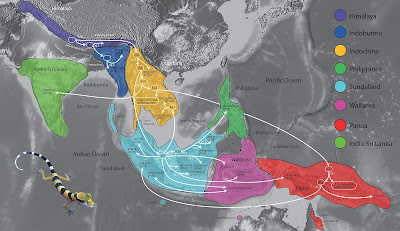 |
| The timing of early colonization routes. Extinct, ancestral taxa are designated as A# and enclosed within rounded rectangles. Arrows originating from a rectangle represent the divergence of an ancestor (A) and its subsequent radiation within the same region and/or colonization of a different region. Arrows originating from a common base represent a single divergence event and the formation of sister lineages. Arrows not sharing a common base (e.g. those originating in A7) represent independent divergence events at different periods in time within that region (e.g. Sundaland). Numbers at the base of all arrows are approximate mean divergence times in millions of years. Base Map created using simplemappr.net. in Grismer, Poyarkov, et al., 2022. DOI: 10.7717/peerj.13153 Photo by L. Lee Grismer. |
Abstract
The gekkonid genus Cyrtodactylus is the third largest vertebrate genus on the planet with well over 300 species that range across at least eight biogeographic regions from South Asia to Melanesia. The ecological and morphological plasticity within the genus, has contributed to its ability to disperse across ephemeral seaways, river systems, basins, land bridges, and mountain ranges—followed by in situ diversification within specific geographic areas. Ancestral ranges were reconstructed on a mitochondrial phylogeny with 346 described and undescribed species from which it was inferred that Cyrtodactylus evolved in a proto-Himalaya region during the early Eocene. From there, it dispersed to what is currently Indoburma and Indochina during the mid-Eocene—the latter becoming the first major center of origin for the remainder of the genus that seeded dispersals to the Indian subcontinent, Papua, and Sundaland. Sundaland became a second major center of radiation during the Oligocene and gave rise to a large number of species that radiated further within Sundaland and dispersed to Wallacea, the Philippines, and back to Indochina. One Papuan lineage dispersed west to recolonize and radiate in Sundaland. Currently, Indochina and Sundaland still harbor the vast majority of species of Cyrtodactylus.
Conclusions:
The dispersal and colonization capabilities of the hyper-diverse gekkonid genus Cyrtodactylus are not greatly influenced by well-established biogeographic barriers as evidenced by their ability to cross seaways, major river systems, basins, mountain ranges, and ephemeral land bridges—followed by extensive in situ diversification within specific geographic areas and habitats. Cyrtodactylus originated in a proto-Himalayan landscape during the early Eocene and later dispersed into and radiated in Indoburma and Indochina. The Indoburma radiation remained in situ but the Indochina radiation became a major center of origin that since the Late Eocene, seeded the evolution of the remainder of the genus with three independent dispersal events and subsequent radiations in Sundaland, India-Sri Lanka, and Papua. The Sundaland radiation became a second major center of radiation during the Oligocene with dispersals and subsequent dispersals and radiations in Wallacea, the Philippines, and back to Indochina. A Miocene dispersal from Indochina to Papua and another from Papua to Sundaland are difficult to explain given that the intervening geographic region (Wallacea) existed only as a series of small islands. The discovery of related species in Wallacea would add further support to what at this point can only be hypotheses of over-water dispersal.
L. Lee Grismer, Nikolay A. Poyarkov, Evan S.H. Quah, Jesse L. Grismer and Perry L. Wood Jr. 2022. The Biogeography of Bent-toed Geckos, Cyrtodactylus (Squamata: Gekkonidae). PeerJ. 10:e13153. DOI: 10.7717/peerj.13153